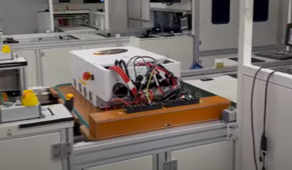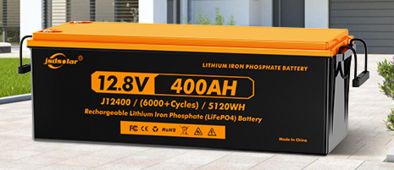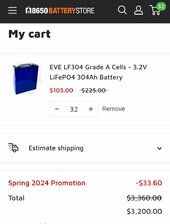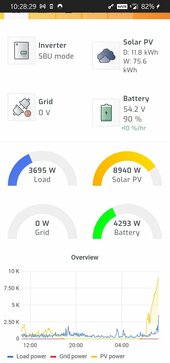You are using an out of date browser. It may not display this or other websites correctly.
You should upgrade or use an alternative browser.
You should upgrade or use an alternative browser.
New 10kw NHX AIO From Watts247
- Thread starter Kornbread
- Start date
Which rack mount batteries support this protocol natively?1) pylontech protocol canbus
Battery protocols are "just" software, so perhaps future firmware updates can enlarge the options?
That is equipment dependent.2) 13ms, what is the max before issues?
I would expect anything over 20 ms to be a problem. Under 10 ms should be fine. 13 ms is probably okay.
Many power supplies are rated for about 10 ms hold up time (how long they can provide power with loss of AC input) at rated load, but few are run right at the max rating.
Don't we all.3) That's a question all of us would like to know the answer to.
Mike C.
IMO. Thinking about it, if I were building a solar system for someone who was remote and the system must be reliable because the that person wasn't great with electrical stuff, I'd probably do something like SolArk or MidNite, not necessarily the new to be out MidNite aio, but their proven separates.Which rack mount batteries support this protocol natively?
Battery protocols are "just" software, so perhaps future firmware updates can enlarge the options?
That is equipment dependent.
I would expect anything over 20 ms to be a problem. Under 10 ms should be fine. 13 ms is probably okay.
Many power supplies are rated for about 10 ms hold up time (how long they can provide power with loss of AC input) at rated load, but few are run right at the max rating.
Don't we all.
Mike C.
$.02
Sol-Ark unit that fits the specs is Sol-Ark 15K-2P-N. The 12K is only 9 KW AC output despite the "12K' in the name. Cost is $7000.IMO. Thinking about it, if I were building a solar system for someone who was remote and the system must be reliable because the that person wasn't great with electrical stuff, I'd probably do something like SolArk or MidNite, not necessarily the new to be out MidNite aio, but their proven separates.
The EG4 18KPV would do the job, $4900 now.
MidNite MN15-12KW-AIO published specs meet the criteria, but it is vaporware and we would be an early adopter. Price is unknown but likely in the $5000 range.
The Growatt SPH 10000TL-HU-US seems like it would meet the need, but is also vaporware as far as I can tell. No price that I can find, feels like $3000ish.
The Amensolar (sold by Watts247) N3H-X10-US is $2200. The Sungold SG10KHB-48 is apparently identical based on same specs and manual info, for $2400. This also appears to be a Megarevo R10KLNA with minor tweaks.
That's a wide spread in cost for what should be basically the same capabilities.
Any other choices? I need minimum 10 KW AC (both from PV and from battery), 12 KW PV input, 3 MPPT, grid interactive, 48 VDC battery, sub 15 ms switchover time. Not a lot of choices in that space.
My solution to the remote service issue is to provide a transfer switch that moves all inverter supplied circuits back to the grid. If there are problems, just throw that switch to move backup panel directly to grid. This is no worse than what they have now. If they leave the inverter grid breaker active, the unit can still feed the grid if able, and I can still communicate with it remotely in case that helps fix it. Flipping that breaker removes the unit entirely from the system as well.
A factor I may not be putting enough weight on would be how good the remote control app is. If the problems can be diagnosed and solved by remote control, that is useful. For the Amensolar/Sungold unit, they have a remote app but I have no idea if it is any good, and whether it is monitoring only or has remote configuration capability.
Another concern is if I move the unit to Solar Assistant, do I only get remote monitoring but not remote control? The ideal would be the ability to add Solar Assistant without removing the default Wifi adapter, but the SA port seems to be the same connector, so one or the other.
Mike C.
The new srne is now out and parallel capable, check out https://diysolarforum.com/threads/4-mwh-srne-asf48100u200-h-10kw.67809/
It sounds like you are heavily weighting price when it comes to price/reliability. IMO, brands like SolArk, Outback, MidNite (the older proven stuff, not their soon to be released aio, hey, it's new and even MidNite might miss a few bugs) that have a proven track record but us diy'ers like to have our cake and eat it too, especially when it comes to a bargain, so we work around bugs and quirks and get a $ deal in the process. We've seen the nightmare Will had with the Megarevo. Hopefully, Ian has worked out the bugs with the nhx remake. Fingers crossed. My $.02, it's a tradeoff. Can we hedge a bet? Certainly.
Batteries w/pylontech, don't know. Check out some of your favorite brands, comms should be somewhere in their description. FWIW, earlier in this thread it is mentioned that SigSolar has a battery communication hub. It's probably a long shot, but I'm wondering if that might also work to convert some other than eg4 batteries and bms's to pylontech. If I were more tech savvy and wanted to give SigSolar more $, I'd give it a try.
Been running SolarAssistant for 2+ years and do not plan on using whatever app comes with the nhx. Check out the SA website https://solar-assistant.io/ Wish their website listed all the functions available with xxx inverter using SA.
It sounds like you are heavily weighting price when it comes to price/reliability. IMO, brands like SolArk, Outback, MidNite (the older proven stuff, not their soon to be released aio, hey, it's new and even MidNite might miss a few bugs) that have a proven track record but us diy'ers like to have our cake and eat it too, especially when it comes to a bargain, so we work around bugs and quirks and get a $ deal in the process. We've seen the nightmare Will had with the Megarevo. Hopefully, Ian has worked out the bugs with the nhx remake. Fingers crossed. My $.02, it's a tradeoff. Can we hedge a bet? Certainly.
Batteries w/pylontech, don't know. Check out some of your favorite brands, comms should be somewhere in their description. FWIW, earlier in this thread it is mentioned that SigSolar has a battery communication hub. It's probably a long shot, but I'm wondering if that might also work to convert some other than eg4 batteries and bms's to pylontech. If I were more tech savvy and wanted to give SigSolar more $, I'd give it a try.
Been running SolarAssistant for 2+ years and do not plan on using whatever app comes with the nhx. Check out the SA website https://solar-assistant.io/ Wish their website listed all the functions available with xxx inverter using SA.
SRNE ASF48100U200-H. Only has 2 MPPT which won't match my array. 2 strings is either too much voltage, or doubling a string is too much current for the ratings. Also, max PV array size is 11 KW, my array will be 11.7 KW. It just isn't a fit.The new srne is now out and parallel capable, check out https://diysolarforum.com/threads/4-mwh-srne-asf48100u200-h-10kw.67809/
I can't find anything SRNE makes that fits my use case.
The difference between $2200 and $7000 is very significant. Maybe the $2200 unit is the wrong one, but if so, that's less than 15% of the system cost, so I can replace it. If it works, that's dandy, if it doesn't, less money was risked. Based on Ian's videos, it does work at least to some degree.It sounds like you are heavily weighting price when it comes to price/reliability.
My parents are funding the system, they are retirees, so making the system inexpensive and with a short payback period is part of the objective here.
Wish the same.Been running SolarAssistant for 2+ years and do not plan on using whatever app comes with the nhx. Check out the SA website https://solar-assistant.io/ Wish their website listed all the functions available with xxx inverter using SA.
It is just so hard to get definitive information about what works with what. Will battery X work with inverter Y (with BMS comms)? What level of remote control will SA provide with inverter Y? You just don't know.
Mike C.
Zwy
Emperor Of Solar
SRNE ASF48100U200-H. Only has 2 MPPT which won't match my array. 2 strings is either too much voltage, or doubling a string is too much current for the ratings. Also, max PV array size is 11 KW, my array will be 11.7 KW. It just isn't a fit.
I can't find anything SRNE makes that fits my use case.
You purchase a pair for 20Kw total and you get 4 MPPT's. The stackable version of SRNE ASP has finally become available. https://www.aliexpress.us/item/3256806593147953.html?gatewayAdapt=glo2usa4itemAdapt As for array size, just because a charge controller is rated for 11Kw doesn't mean you will have panels that can meet that max capacity, it doesn't matter the charge controller, either you hit the max VOC or go over on amperage (over panel which is perfectly fine if you want to do it). With 2 units, you would have 22Kw max PV capacity.
For that price, I'm tempted to snag a pair and test them, then have those either in my shop or backup for my house.
The difference between $2200 and $7000 is very significant. Maybe the $2200 unit is the wrong one, but if so, that's less than 15% of the system cost, so I can replace it. If it works, that's dandy, if it doesn't, less money was risked. Based on Ian's videos, it does work at least to some degree.
My parents are funding the system, they are retirees, so making the system inexpensive and with a short payback period is part of the objective here.
If $2960 breaks the bank for a pair of the SRNE AIO's, then they probably should not be adopting solar power.
I run without comms, I find it unnecessary.Wish the same.
It is just so hard to get definitive information about what works with what. Will battery X work with inverter Y (with BMS comms)? What level of remote control will SA provide with inverter Y? You just don't know.
Mike C.
my array is planned as 36-370w panels into a single SRNE 10kw.SRNE ASF48100U200-H. Only has 2 MPPT which won't match my array. 2 strings is either too much voltage, or doubling a string is too much current for the ratings. Also, max PV array size is 11 KW, my array will be 11.7 KW. It just isn't a fit.
I don’t know your panel specs but at 9s2p I’m at (see pic) per input

Which only over panels me by 1100w per input which will only clip on perfect days, otherwise it should be a non issue.
Fortunately my panels allow me to parallel without exceeding input amps
And extra wiring, space, breakers, panels, etc. Buying a second inverter just to get 2 MPPTs sounds illogical when I can buy one $2200 inverter with 4 MPPT that match my array plans, so why not do that?You purchase a pair for 20Kw total and you get 4 MPPT's.
That's the hill billy solution to battery protocols, I suppose.I run without comms, I find it unnecessary.
I would prefer the system have battery comms and one can track the battery condition in the inverter. There are possible issues that could be problematic without comms, like one pack shuts down and the inverter doesn't know about it.
Mike C.
The panel rated current is ~13 amps, so double that is over the 22 amp MPPT spec on the SRNE.my array is planned as 36-370w panels into a single SRNE 10kw.
I don’t know your panel specs but at 9s2p I’m at (see pic) per input
With 30 panels of 390 W, you would need to make 10s2p for one MPPT, and 10s1p for the other. Doable, I suppose, but the double input will clip when you get full sun.
Your post implies MPPT behavior I was not aware of, that is, the MPPT will back off max power if the current limit of the input is being reached. Is that how they operate or do they only adjust to the max power even if that is over the input current limit?Which only over panels me by 1100w per input which will only clip on perfect days, otherwise it should be a non issue.
Mike C.
Zwy
Emperor Of Solar
And extra wiring, space, breakers, panels, etc. Buying a second inverter just to get 2 MPPTs sounds illogical when I can buy one $2200 inverter with 4 MPPT that match my array plans, so why not do that?
Then buy it. You seem to have your mind made up already so why not just do it?
That's the hill billy solution to battery protocols, I suppose.
Well, I guess I'm done with this discussion.I would prefer the system have battery comms and one can track the battery condition in the inverter. There are possible issues that could be problematic without comms, like one pack shuts down and the inverter doesn't know about it.
Mike C.
Yes, the mppt limits production and the reason you can safely overpanel most mppts, to an extent. Many people overpanel so they can harvest more on cloudy days/winter knowing they will loose some production on sunny days as the mppt clips.Your post implies MPPT behavior I was not aware of, that is, the MPPT will back off max power if the current limit of the input is being reached. Is that how they operate or do they only adjust to the max power even if that is over the input current limit?
Mike C.
Battery comm is not all golden. Look at the eg4 LiFePower4, when communicating with my Growatt, the battery's baked in settings commanded the inverter to charge to ~58v, roughly 3.645v per cell. Look at the charge/discharge profile of a LiFePo4 cell and you will see maybe ~10% of its available power comes from the knees. Other than giving a passive balancer something to do, there really is no reason to take LiFePo4 cells that high. SolarAssistant shows all I need to know about my battery bank with jk bms that do not communicate with the inverter.

If your at 13a per string then your max 26a. So you may see a bit more clipping than I would. But that is correct the MPPT will “throttle” input to not exceed 22aThe panel rated current is ~13 amps, so double that is over the 22 amp MPPT spec on the SRNE.
With 30 panels of 390 W, you would need to make 10s2p for one MPPT, and 10s1p for the other. Doable, I suppose, but the double input will clip when you get full sun.
Your post implies MPPT behavior I was not aware of, that is, the MPPT will back off max power if the current limit of the input is being reached. Is that how they operate or do they only adjust to the max power even if that is over the input current limit?
Mike C.
You could run 7s2p into each input and use 28 of 30 panels
42OhmsPA
What's in a title?
7s2p with 370W panels on MPPT1 (just over 22A max) , 9s2p with 315W panels on MPPT2 (just over the 5500W max). Voltage is happy and well within theIf your at 13a per string then your max 26a. So you may see a bit more clipping than I would. But that is correct the MPPT will “throttle” input to not exceed 22a
You could run 7s2p into each input and use 28 of 30 panels
No comms between batteries and inverter.
Over 4mWh solar production with this setup and no major issues or drawbacks that I can see.
The NHX looks promising but I'm almost certain I'm sticking with the parallel version of what I'm running for the next upgrade.
Attachments
I can appreciate the comfort of having something that has worked for you.The NHX looks promising but I'm almost certain I'm sticking with the parallel version of what I'm running for the next upgrade.
One of my misgivings with the SRNE inverter is that it isn't sealed. The Amensolar, Megarevo, Sungold inverter is sealed, IP65. When it is mounted in the humid dusty garage in Florida, having the fans not drag moisture and dust over the high voltage electronics is a good idea. I would judge the sealed unit is going to have less long term problems for that reason. Everything in Florida corrodes in the humid and salty air.
I did find a video of this style of inverter being built:
It appears to be the slightly older version than what is sold now (flat face panels instead of chamfered). The video is fairly impressive, a modern process. What I can see of the design looks well done.
Inside showing heat transfer pads:

Main inverter power board:

Putting in the relay and control board:

Automated test and burn in:

The production process feels first rate to me. That doesn't mean it is a good design, however, but it is hopeful.
Mike C.
Okay, so if battery comms are not a thing you need, then maybe you can buy cheaper batteries that lack comms altogether.No comms between batteries and inverter.
For example, 4 of these in series:

$900 each. For $3600, you get 51.2V, 400 AH, 20.5 KWH. Free shipping, which is non trivial with ~90 lbs batteries. To replicate this with rack mounts, it would cost about $5000.
What is the downside to that plan?
If you believe this video, those units produced 433 AH at about 0.1 C discharge.
Mike C.
42OhmsPA
What's in a title?
The SRNE HES / HESP is sealed(IP65); the ASF / ASP is not sealed. They seem to have a nice factory as well.I can appreciate the comfort of having something that has worked for you.
One of my misgivings with the SRNE inverter is that it isn't sealed. The Amensolar, Megarevo, Sungold inverter is sealed, IP65. When it is mounted in the humid dusty garage in Florida, having the fans not drag moisture and dust over the high voltage electronics is a good idea. I would judge the sealed unit is going to have less long term problems for that reason. Everything in Florida corrodes in the humid and salty air.
I did find a video of this style of inverter being built:
It appears to be the slightly older version than what is sold now (flat face panels instead of chamfered). The video is fairly impressive, a modern process. What I can see of the design looks well done.
Inside showing heat transfer pads:
View attachment 210452
Main inverter power board:
View attachment 210453
Putting in the relay and control board:
View attachment 210454
Automated test and burn in:
View attachment 210455
The production process feels first rate to me. That doesn't mean it is a good design, however, but it is hopeful.
Mike C.
Sungold is just relabeling other brands.
The NHX looks nice and I look forward to more reports of it in the wild.
42OhmsPA
What's in a title?
I want and need battery comms, that's why my BMS's talk to Solar Assistant. I don't want or need inverter / battery comms. I use appropriate safe voltages and tail current.Okay, so if battery comms are not a thing you need, then maybe you can buy cheaper batteries that lack comms altogether.
For ~$4000 with shipping and BMS's you can get ~31kWh and build your own that are easily serviceable.For example, 4 of these in series:
View attachment 210461
$900 each. For $3600, you get 51.2V, 400 AH, 20.5 KWH. Free shipping, which is non trivial with ~90 lbs batteries. To replicate this with rack mounts, it would cost about $5000.

Haha, lots. Mainly keeping the 12V packs in balance, not being able to service them and not being able to monitor cells.What is the downside to that plan?
If you believe this video, those units produced 433 AH at about 0.1 C discharge.
Mike C.
Regardless what we choose all that matters is we are happy with our system.
Sorry @Kornbread I'll stop derailing your thread now.
It's good @42OhmsPA I was about to suggest the possibility of @mciholas building the battery from cells, especially now that cells and active bms's are very reasonable and they are lots of resources out there to help, besides, not all 12v LIFePo4 are capable of being connected in series.
Not a fan of Amazon, they still have not shipped the breakers and din rail boxes so I can get further on the install.
Not a fan of Amazon, they still have not shipped the breakers and din rail boxes so I can get further on the install.





